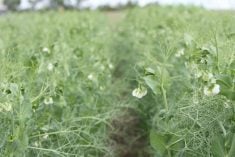The size and shape of the 2001 prairie oats crop is still unknown, as drought in the western areas and excessive rain in the east have shaken up many seeding plans.
But the most compelling mystery to Grande Prairie, Alta., oat grower Leo Meyer lies in the future, when the crop might suddenly become popular.
“For me, all the bets are off for prices,” said Meyer, who is also the Alberta vice-president of the Prairie Oat Growers Association.
“I think we could go significantly higher. I feel good about oats.”
Read Also

Prairies have variable soil moisture conditions
The dry weather in the west was welcome for preserving grain quality and advancing harvest, but it has resulted in very dry soil moisture conditions.
To Meyer, the good potential for oats doesn’t come from big swings in production and stockpiles, but from what’s happening to other crops.
He thinks production may be down somewhat this year because of poor recent prices and early seeding in Alberta and parts of Saskatchewan, which may have led some producers to switch acres from oats to wheat.
Production will probably be down in Manitoba, even if acreage remains constant. That’s because many crops, especially in eastern Manitoba, are going in late, which will cut yield.
The biggest potential for oats in Alberta comes from the drought that has kept hay crops short, Meyer said. Many cow-calf producers are getting desperate.
“There’s going to be some very good opportunities to sell oats as greenfeed for some very significant prices,” said Meyer.
“It may be worthwhile to bale.”
Oats make excellent greenfeed. Greenfeed is usually a low-value use for oats, but it might become an attractive option if hay crops wither. Many Alberta producers can’t do without adequate roughage and are trying to buy hay right now.
Meyer also is beginning to see more demand for greenfeed oats from pelleting plants. That’s because many alfalfa crops were badly hurt by winterkill and the plants need substitute feed sources.
Meyer thinks some producers are already looking at oats as a solution for their feed problems and are seeding more acres.
Oats seed is selling fast in his part of Alberta, he said.
In Manitoba, where the bulk of Canada’s export crop is grown, eventual acreage is anybody’s guess.
“There’s an equal number of the trade that think oats acreage will be up and an equal number that think it will be down,” said Dennis Galbraith, the manager of procurement for Can-Oat Milling.
“We’ve got such an unusual spring that the seeding estimates that Statistics Canada puts out on June 30 is likely to be a bit different.
“I don’t know what to think.”
In Manitoba, the wild card is more likely to be yield than area, Galbraith said. Acreage might be steady with spring forecasts, but late seeding means a great crop is unlikely.
“I don’t think we’ll see record production unless we get a really good summer,” said Galbraith.
“Ideal seeding time was done two weeks ago.”
Some major oat pro-cessors in the United States are able to store up to half a year of supply, so they are unlikely to fret about the uncertainty, Galbraith said.
Can-Oat, which doesn’t have big storage facilities, is taking a wait-and-see approach since “there’s not much we can do.”
Galbraith is well acquainted with the troubling conditions that have made this year’s Manitoba seeding season a torment.
As he spoke, he was in the middle of a field his brother and he were trying to seed to oats. It was a dry, blue sky day, but they were hurrying because that kind of weather isn’t lasting this year.
“We were rained out twice yesterday,” said Galbraith.
“We keep getting these showers that knock us out of the field.”
The land he was seeding still had pools of standing water that he had to avoid. Across the road that morning, a Hutterite colony’s air seeder got so badly stuck that the farmers had to break it into three pieces to drag it out.















